Knowing how to properly detail and wash a cherished car with a microfiber towel is one of those basic skill sets expected of a true automotive aficionado. Websites such as Topcoat F11 offer microfiber towels for a good price if you’re looking. Once The tiny, incredibly durable nylon, polyester, and Kevlar strands of these recent entrants to the consumer auto care marketplace measure around 1 percent the diameter of a human hair, but when woven super-tightly, their superior absorbency and innate knack for capturing dirt and dust instead of merely smearing it across your ride’s surface renders touchless car washes nearly obsolete.
Table of Contents
Microfiber Towels
Once you get past the initial sticker shock of stocking up on some appropriate professional-grade cleaning products and take in the remarkable difference hand-washing with a microfiber towel makes on every surface, you may never even so much as slow down to look at a commercial car wash again. Please, enjoy a few free, handy beginner tips.

Prep Your Cleaning Area
In addition to a few microfiber towels, you will need at least a bucket, plenty of water, and specially formulated car wash soap for an ideal finish. Any other protective coatings, waxes, or other materials may top off your handiwork nicely, but that depends entirely on your preference. Pre-wash Products will make the preparation easy for you. Properly hand-washing a vehicle from top to bottom may call for lots of water as you wet, wash and rinse, so try to set up near a plentiful source. Since direct sunlight will dry car wash soap onto your paint job before you have a chance to rinse it away, always look for some shade. If there’s no dodging the sun, you can still prevent premature drying by washing one smaller section at a time.
Next, prepare your supplies by filling the bucket. Cold water will do, but warmer temperatures will better dissolve car wash soap when mixed according to instructions. While you soak a microfiber towel in the sudsy blend, lift the wiper arms upright for better access to every inch of your windshield and rinse away as much loose dirt as possible over every exterior inch before breaking out the real elbow grease.
Washing Your Car
Start by wiping each panel with a soapy microfiber towel, starting from the roof and working your way down. Save any heavily soiled areas for last. Just a reminder: as you systematically wash one panel at a time, keeping each area fairly small makes sure the soap won’t dry onto the paint in warm temperatures or direct sunlight. Holding your microfiber towel with a wide, open-handed grip will minimize the time it takes to maximize the dirt picked up across the largest possible surface area. When you get to the windshield, your towel can also thoroughly clean the wiper blades and arms, but do so without lowering the arms themselves at this point. Your wheels should wait for the end of your cleaning, since accumulated brake dust, grime, and dirt may contaminate your soapy water with especially abrasive particles capable of badly scratching your paint. For that very reason, your microfiber towels will need a rinse whenever you wipe down a dirty area. Remove any gritty pieces before continuing your cleaning, and soak more than cloth to get the job done if your car happens to be especially soiled.
Once you have cleaned every panel, thoroughly rinse the car with clean water from a hose or separate bucket. Again, start from the roof and windows. Rinse every panel until no more suds show up in the water. This will ensure no leftover soap leaves dried streaks or residue on your paint.
Drying Your Car
As the job nears its end, your microfiber towels can also thoroughly dry your car. After soaking the cloth with clean water and thoroughly wringing out as much moisture as possible to optimize absorbency, keep it as open as possible with an open hand while wiping every window and panel individually from the top down to the wheels. Spreading soapy water will leave streaks as it dries, so rinse out soiled towels with clean water as you work. Wringing out each towel like a chamois will keep it almost entirely dry. A thin film of water will linger on each panel as you wipe everything down. Allowing it to air dry won’t necessarily hurt anything, but wiping the excess away with clean, dry towels will leave behind the cleanest, shiniest streak-free finish possible.
Another Option: Spray-on Cleaner
There is another way to professionally clean and detail your car with a microfiber towel: use spray-on cleaners for an easy, waterless car wash. First, apply the cleaning solution of your choice in an even coating as directed. Wipe it away both side-to-side and vertically to capture the greatest volume of grime and grease. After repeating the process around the entire vehicle, your handiwork should leave behind a showroom shine. Going this route both saves you effort and drastically cuts back wasted water, an efficient approach with a particularly appreciable value in drought-prone states and cities with conservation-driven ordinances against washing cars in driveways.
Besides being eco-friendly, a waterless car wash with a microfiber towel and specialized cleaning solution will often clean any vehicle even more neatly than using soap. Consider it the ultimate win-win.












